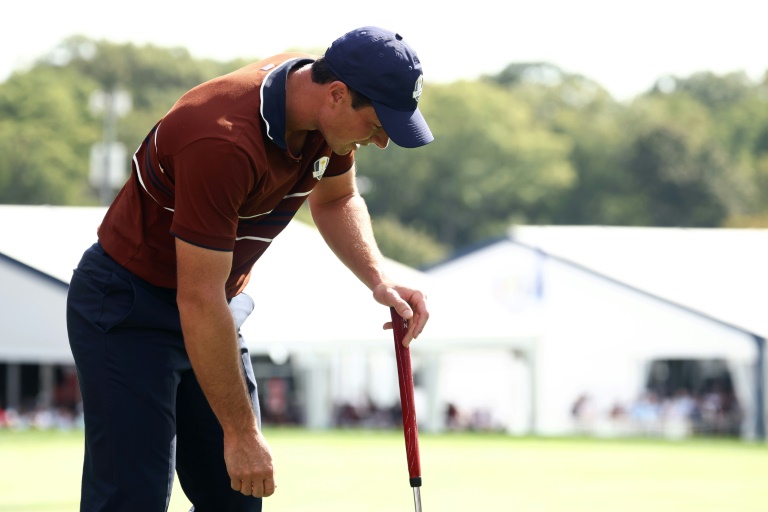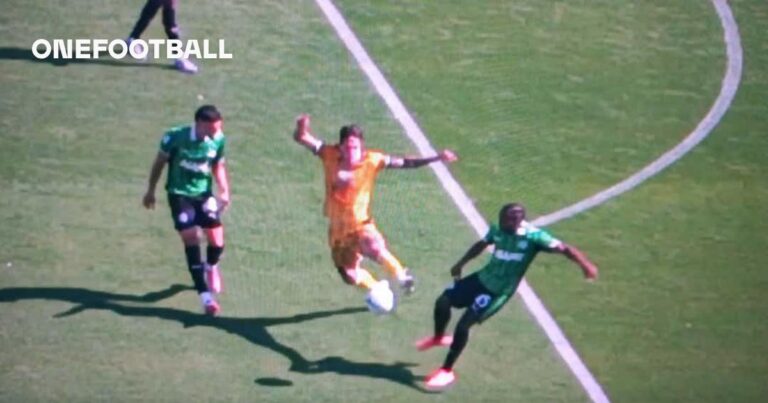The Athletic has live coverage of the 2025 U.S. Open, and you can follow all the U.S. Open coverage too.
Welcome to the U.S. Open briefing, where The Athletic will explain the stories behind the stories on each day of the tournament.
Advertisement
On day 12, the women’s semifinals produced two thrilling matches, while a great wheelchair tennis rivalry resumed at Flushing Meadows.
Redemption for Anisimova, again
The Amanda Anisimova redemption tour rolls on.
Not content to merely exorcise the the ghosts of her 6-0, 6-0 defeat to Iga Świątek in the Wimbledon final, Anisimova climbed back from a wrenching loss in a first-set tiebreak to beat Naomi Osaka 6-7(4), 7-6(3), 6-3 in the early hours of this morning.
It sets up a U.S. Open final against Aryna Sabalenka, the reigning champion in New York and the player Anisimova stunned for the right to face Świątek in that Wimbledon final that turned into a nightmare rout.
Advertisement
Late in the second set at Arthur Ashe Stadium, Anisimova had looked spent. She heaved for oxygen after nearly every point. But she kept grinding, and as Osaka slipped, suddenly missing the court on four consecutive points in the second set tiebreak, Anisimova surged:
Anisimova’s strokes had the same frozen-rope surety that had gotten her past Świątek in the quarterfinal.
Her serves shot off the court, forcing Osaka back on her heels.
And when Osaka, the four-time Grand Slam champion on a mission to regain her form of old, had to spin a second serve into the box, Anisimova nailed them for winners with the authority of someone on a mission.
Advertisement
On a night when neither player was at her best, both of them playing one day after a remarkable quarterfinal win, Osaka was initially a little bit cleaner, especially in the big moments — just as she could be when she was dominating this sport five, six, and seven years ago.
Anisimova tried to claw back, breaking Osaka immediately to open the second set. Osaka immediately came back with a break of her own. That pattern carried through just about all night, with Anisimova broken immediately after breaking four times out of five.
Until it really mattered, when Anisimova summoned the confidence that had seemed to desert her.
She had the chance to serve it out at 5-3, with the few thousand fans who stayed the course to near 1 a.m. screaming to give her that little extra power. Anisimova dialed in, desperately refusing to give Osaka any openings. Her backhand down the line, which she had abandoned after a few misses early in the match even when it was screaming to be hit, took her to 30-0 with a stunner that Osaka could only watch.
Advertisement
Another took her to two match points. Osaka saved one, bouncing on her feet to stave off the next. Anisimova netted. Then she double-faulted. Against Świątek, in two nervous moments, one of them on match point, net cords had given her safe harbor. This time she did it all herself, climbing up from the baseline to pelt a forehand winner and pin Osaka back again.
And with a big inside-in forehand past Osaka, she crouched on her knees at the net, holding her head in her hands. Just 54 days had passed since Anisimova had suffered one of the sport’s greatest humiliations. Now she had grabbed herself another chance at its greatest glory.
“I wasn’t sure I would make it past the finish line,” she said. “I just tried to stay positive.”
— Matt Futterman
Advertisement
Aryna Sabalenka vs. the U.S.
Aryna Sabalenka avoided another late-stage Grand Slam defeat by an American Thursday night, rallying to beat Jessica Pegula 4-6, 6-3, 6-4 and advance to the U.S. Open final.
After previous losses this year to Madison Keys, Coco Gauff and Amanda Anisimova in either the final or the semifinals of the other Grand Slams, Sabalenka finally delivered when it mattered most:
The key difference-maker in the first set was the Pegula return. Sabalenka made 74 percent of her first serves, more than in either of the sets she won, but Pegula had an incredible read on it. That neutralized the advantage Sabalenka would have expected, and forced her into going for too-small margins.
Advertisement
Pegula had been doing a great job of keeping Sabalenka off balance in rallies. She constantly jammed her with body serves, to stop her from unleashing returns. But in the second set, Sabalenka took over, dropping just seven points on serve as she eased the match into a decider.
Pegula’s rally tolerance had dropped, but down 4-2, she rediscovered her ability to smother Sabalenka with deep returns. Sabalenka had to fend off three break points, one with excellent net play and two with backhand winners. Sabalenka only won four returning points in the third set, but that was enough to pinch a single break of serve. Pegula won 15, but to no avail.
Under pressure throughout the final set, Sabalenka just about hauled herself over the line, an ace setting up match point. She earned a smash with a powerful approach shot but thundered it into the net. After staring in disbelief, she thumped away a backhand winner and yelled into the New York night.
On the second match point, Pegula fired a passing shot at Sabalenka’s toes so that she could not dig out a volley, but the world No. 1 secured the win at the third attempt, burying a forehand winner and screaming to the heavens in celebration.
Advertisement
So far this year, Sabalenka failed to defend her title in the Melbourne final, then fell at the last hurdle at the French Open. She has the chance to make it third time lucky Saturday.
— Charlie Eccleshare
A rivalry of over a decade returns to the U.S. Open
Great sporting rivalries need a plethora of factors. Intense competition; contrasting personalities; enough meetings to hold interest and the magic of each person or team involved elevating the other in pursuit of greatness.
So how’s this: An individual rivalry that spans over 60 matches and 11 years, played out at the highest level of an individual sport, on its greatest stages.
Advertisement
Diede de Groot and Yui Kamiji played out their 65th meeting Thursday, in the quarterfinals of the U.S. Open wheelchair championships. Kamiji, 31, secured her fourth consecutive win over de Groot, 28, in a close three-set match, with de Groot taking the first set before Kamiji came back to take the next two 6-4, 6-4. Their most memorable recent meeting had been in the final of the 2024 Paralympic Games in Paris, in which Kamiji, who plays left-handed, also won in three sets from a set down.
This recent surge stands in opposition to the long arc of their rivalry. De Groot leads their head-to-head 46-18, including a 29-match streak between 2021 and 2024. Kamiji snapped that streak at a tournament in the U.K. just ahead of the Paralympics, and carried that confidence into the biggest match in their shared history. She even did a little extra, partnering with Manami Tanaka to beat de Groot and Aniek van Koot in the women’s doubles gold medal match. It was the first time the Netherlands had not won women’s doubles gold since 1992.
Now, Kamiji is into another Grand Slam semifinal. Another chapter in their story hopefully awaits in Melbourne in 2026.
— James Hansen
Advertisement
Shot of the day
In one sense, this is a regulation backhand down the line. For Amanda Anisimova against Naomi Osaka, it was everything.
Up next: Men’s semifinals
🎾 Novak Djokovic (7) vs. Carlos Alcaraz (2)
3 p.m. ET on ESPN/ESPN+
Djokovic has won the last two meetings in this rivalry, both of them coming in very particular circumstances. At January’s Australian Open, Alcaraz was a game away from the first set when Djokovic received treatment for what the world would later learn was a hamstring tear. But during the rest of the match, he limped into Alcaraz’s brain and scrambled it from the inside, winning in four sets. Before that, Djokovic beat Alcaraz in the 2024 Paris Olympic final, playing the best tennis of his late years — and winning in two tiebreaks. To underline the point: Djokovic can win this match, but he will need some help from whatever tennis Gods are up there, or from Alcaraz, to do it.
Advertisement
🎾 Jannik Sinner (1) vs. Félix Auger-Aliassime (25)
Not before 7 p.m. ET on ESPN/ESPN+
Auger-Aliassime has been on an old-fashioned heater this tournament, reaching his first Grand Slam semifinal in four years on the strength of his vicious forehand and powerful serve. He faces the defending champion, who has looked imperious all tournament barring a match against Denis Shapovalov, whose tactics Auger-Aliassime cannot really replicate. The Canadian does have the weight of shot to hamper Sinner, but he will need to change rhythm and direction too to truly disrupt the world No. 1.
U.S. Open men’s draw 2025
U.S. Open women’s draw 2025
Tell us what you noticed on Day 12…
This article originally appeared in The Athletic.
Tennis, Women’s Tennis
2025 The Athletic Media Company








